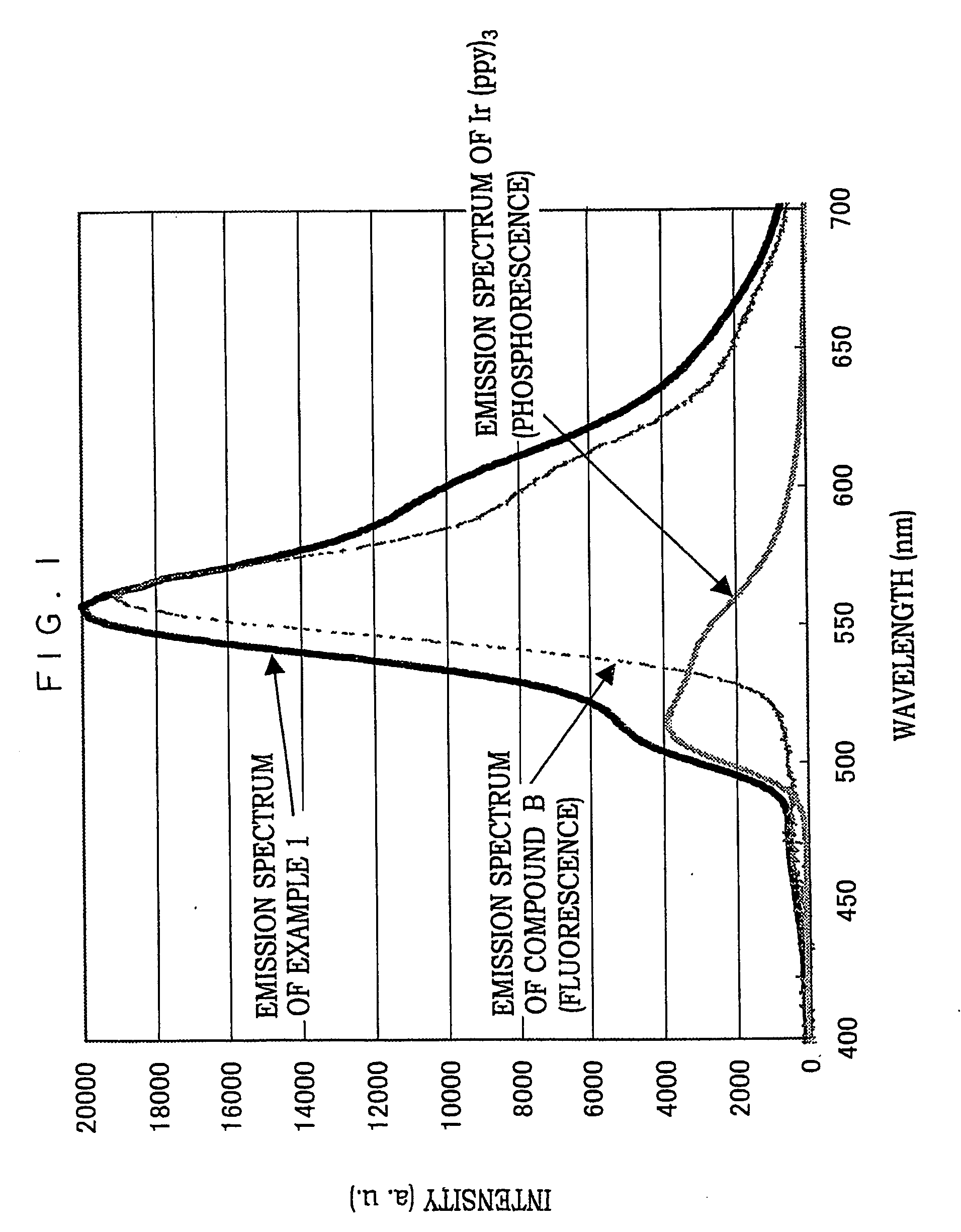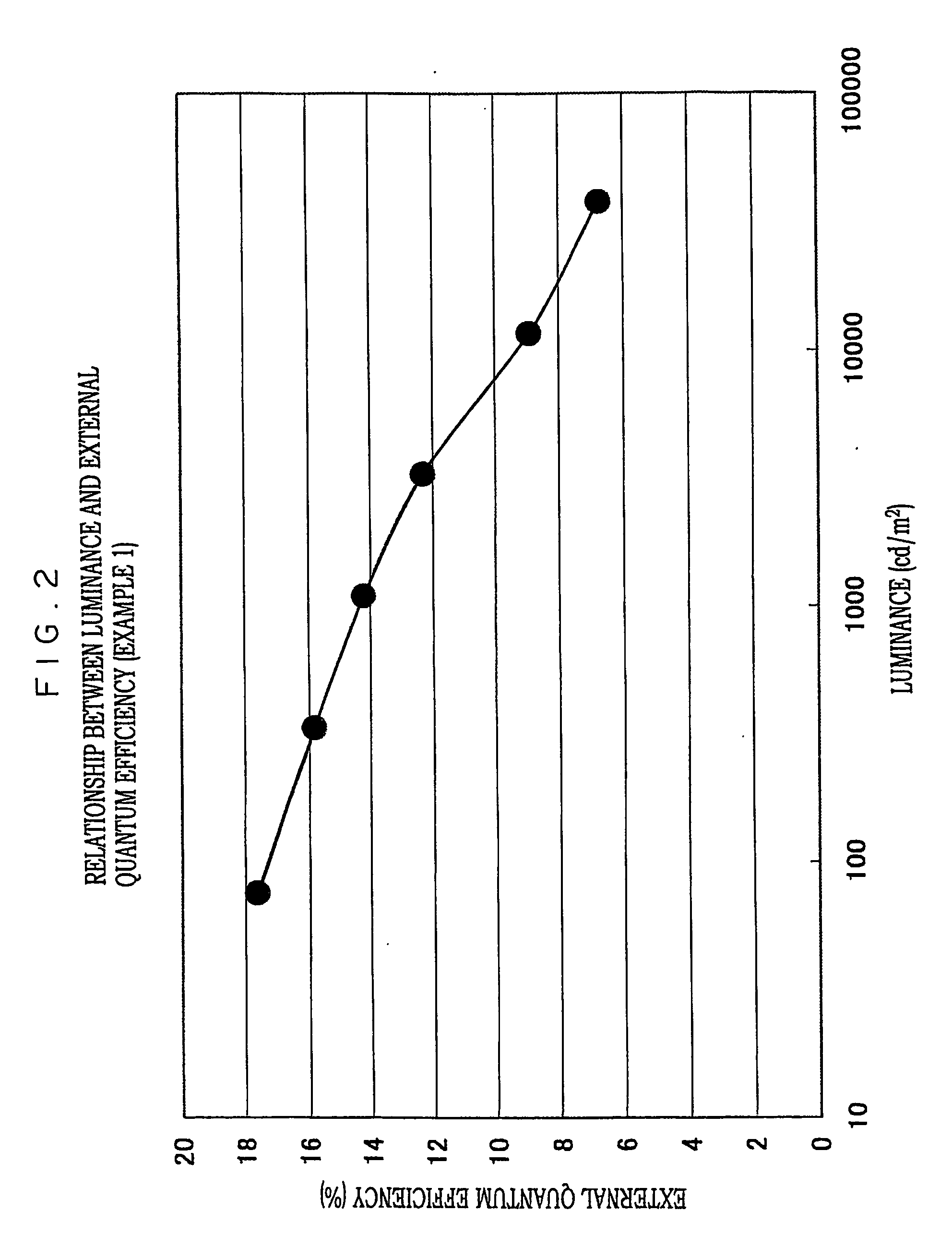Organic electroluminescent device
an electroluminescent device and organic technology, applied in the direction of discharge tube luminescnet screens, other domestic articles, natural mineral layered products, etc., can solve the problems of slow response to light emission and persisting durability, and achieve the effect of amplifying the intensity of light emission and high degree of efficiency
- Summary
- Abstract
- Description
- Claims
- Application Information
AI Technical Summary
Benefits of technology
Problems solved by technology
Method used
Image
Examples
example 1
[0183] A cleaned ITO substrate was set in a vacuum deposition apparatus. N,N′-diphenyl-N,N′-di(m-tolyl)benzidine (TPD) was deposited on the substrate to a thickness of 50 nm. Then, a compound A (host material) and a compound B (compound emitting fluorescence) were deposited on the TPD layer in a ratio of 99:1 to a deposition thickness of 1 nm. Then compound A and Ir(ppy)3 (amplifying agent) were deposited on the TPD layer in a ratio of 17:1 to a deposition thickness of 1 nm. This process was repeated 18 times, and an alternate laminated film of 36 nm in total was formed. In this case, a crucible in which compound A and compound B had been poured and a crucible in which compound A and Ir(ppy)3 had been poured were heated to temperatures at which the crucibles could be constantly deposited. Deposition was repeated by the switching of a shutter set in the vicinity of the crucible. A compound C was deposited thereon to a deposition thickness of 36 nm. A pattern mask (having a pattern gi...
example 2
[0184] Alq3 was used in place of compound C in Example 1, and the device was fabricated and tested in the same manner as in Example 1. As a result, the yellow light emission of maximum light-emitting wavelength λ max=565 nm and CIE chromaticity (x,y)=(0.47, 0.51) were obtained, and the external quantum efficiency at 200 cd / m2 was 11.7%. The internal quantum efficiency was calculated to be 58.5%. The light emission was mainly derived from compound B. The proportion accounted for by the fluorescent luminescence of compound B was about 95%. The approximately 5% remaining was accounted for by phosphorescence luminescence derived from Ir (ppy)3.
example 3
[0185] CBP was used in place of compound A in Example 1, and the device was fabricated and tested in the same manner as in Example 1. As a result, the yellow light emission of maximum light-emitting wavelength λ max=550 nm and CIE chromaticity (x,y)=(0.37, 0.56) were obtained, and the external quantum efficiency at 200 cd / m2 was 8.1%. The internal quantum efficiency was calculated to be 40.5%. The light emission was mainly derived from compound B. The proportion accounted for by the fluorescent luminescence of compound B was about 90%. The approximately 10% remaining was accounted for by phosphorescence luminescence derived from Ir(ppy)3.
PUM
| Property | Measurement | Unit |
|---|---|---|
| external quantum efficiency | aaaaa | aaaaa |
| internal quantum efficiency | aaaaa | aaaaa |
| light-emitting wavelength | aaaaa | aaaaa |
Abstract
Description
Claims
Application Information
 Login to View More
Login to View More - R&D
- Intellectual Property
- Life Sciences
- Materials
- Tech Scout
- Unparalleled Data Quality
- Higher Quality Content
- 60% Fewer Hallucinations
Browse by: Latest US Patents, China's latest patents, Technical Efficacy Thesaurus, Application Domain, Technology Topic, Popular Technical Reports.
© 2025 PatSnap. All rights reserved.Legal|Privacy policy|Modern Slavery Act Transparency Statement|Sitemap|About US| Contact US: help@patsnap.com



